Abstract
Saccharomyces cerevisiae as model system was used to evaluate the occurrence of resistant mutants and adaptation mechanism to mancozeb (MZ), a widespread fungicide of the dithiocarbamate class with a broad spectrum of action and multiple cell targets. We were unable to isolate mutants resistant to inhibitory concentration of MZ but found an unusually large number of mitochondrial defective petite mutants among cells incubated in the presence of subinhibitory MZ concentration. Similar results were obtained with two other dithiocarbamate fungicides. Comparison of wild type and petite mutants showed that the latter were more resistant to toxic effects of MZ, highlighting the role of mitochondria in MZ-tolerance. The data suggest that petite cells, arising by exposure to sub-inhibitory MZ concentration, are not induced by fungicides but are spontaneous mutants already present in the population before the contact with the fungicide.
Similar content being viewed by others
Abbreviations
- DTC(s):
-
dithiocarbamate(s)
- EtBr:
-
ethidium bromide
- MIC:
-
minimum inhibitory concentration
- MR:
-
metiram
- MTC(l):
-
mitochondria(l)
- MZ:
-
mancozeb
- PB:
-
propineb
- WT:
-
wild type
- YPD:
-
yeast peptone-dextrose medium
- YPG:
-
yeast peptone-glycerol medium
References
Br∁o N., Tenreiro S., Viegas C.A., Sá-Correira I.: FLR1 gene (ORF YBR008c) is required for benomyl and methotrexate resistance in Saccharomyces cerevisiae and its benomyl-induced expression is dependent on pdr3 transcription regulation. Yeast15, 1595–1608 (1999).
Buck J.W., Burpee L.L.: The effects of fungicides on the phylloplane populations of creeping bentgrass. Can.J.Microbiol.48, 522–529 (2002).
Cabras P., Angioni A.: Pesticide residues in grapes, wine, and their processing products. J.Agric.Food Chem.48, 967–973 (2000).
Calviello G., Piccioni E., Boninsegna A., Tedesco B., Maggiano N., Serini S., Wolf F.I., Palozza P.: DNA damage and apoptosis induction by the pesticide Mancozeb in rat cells: involvement of the oxidative mechanism. Toxicol.Appl.Pharmacol.211, 87–96 (2005).
Chen X.J., Clark-walker G.D.: The petite mutation in yeasts: 50 years on. Internat.Rev.Cytol.194, 197–238 (2000).
Diala E., Mittwoch U., Wilkie D.: Antimitochondrial effects of thioacetamide and ethylenethiourea in human and yeast cell cultures. Brit.J.Cancer69, 1771–1773 (1980).
Dias P.J., Texeira M.C., Telo J.P., Sá-Correira I.: Insights into the mechanisms of toxicity and tolerance to the agricultural fungicide mancozeb in yeast, as suggested by a chemogenomic approach. OMICS J.Integrad.Biol.14, 211–227 (2010).
Domico L.M., Zeevalk G.D., Bernard L.P., Cooper K.R.: Acute neurotoxic effects of mancozeb and maneb in mesencephalic neuronal cultures are associated with mitochondrial dysfunction. Neurotoxicology27, 816–825 (2006).
Domico L.M., Cooper K.R., Bernard L.P., Zeevalk G.D.: Reactive oxygen species generation by ethylene-bis-dithiocarbamate (EBCD) fungide mancozeb and its contribution to neuronal toxicity in mesencephalic cells. Neurotoxicology28, 1079–1091 (2007).
Elskens M.T., Penninckx M.J.: Thiram and dimethyldithiocarbamic acid interconversion in Saccharomyces cerevisiae: a possible metabolic pathway under the control of the glutathione redox cycle. Appl.Environ.Microbiol.63, 2857–2862 (1997).
Fai P.B., Grant A.: A comparative study of Saccharomyces cerevisiae sensitivity against eight yeast species sensitivities to a range of toxicants. Chemosphere75, 289–296 (2009).
Fox T.D., Folley L.F., Mulero J.J., Mcmullin T.W., Thorsnes P.E., Hedin L.O., Costanzo M.C.: Analysis and manipulation of yeast mitochondria genes. Methods Enzymol.194, 149–165 (1991).
Hollomon D.W., Brent K.J.: Combating plant disease — the Darwin connection. Pest.Manag.Sci.65, 1156–1163 (2009).
Kato M., Mizubuti E.S., Goodwin S.B., Fry W.E.: Sensitivity to protectant fungicides and pathogenic fitness of phytophtora infestant in the United States. Phytopathology87, 973–978 (1997).
Liu Z., Butow R.A.: Mitochondrial retrograde signalling. Ann.Rev.Genet.40, 159–185 (2006).
Maroni M., Colosio C., Ferioli A., Fait A.: Biological monitoring of pesticides exposure: a review. Dithiocarbamate pesticides. Toxicology143, 47–51 (2000).
Miles M., Kemmitt G., Valverde P.: Results from two years of field studies to determine Mancozeb based spray programmes with minimal impact on predatory mites in European vine cultivation. Commun.Agric.Appl.Biol.Sci.71, 285–293 (2006).
Parnell S., VAN Den BOSCH F., GILLIGAN C.A.: Large-scale fungicide spray heterogeneity and the regional spread of resistant pathogen strains. Phytopathology96, 549–555 (2006).
Ribeiro I.C., Veríssimo I., Moniz L., Cardoso H., Sousa M.J., Soares A.M.V.M., Leão C.: Yeasts as a model for assessing the toxicity of the fungicides Penconazol, Cymoxanil and Dichlorofluanid. Chemosphere41, 1637–1642 (2000).
Rose M.D., Winston F., Hieter P.:Methods in Yeast Genetics: a Laboratory Course Manual, 2nd ed., pp. 177–186. Cold Spring Harbor Laboratory Press, Cold Spring Harbor 1990.
Santos P.M., Simões T., Sá-Correira I.: Insights into yeast adaptive response to the agricultural fungicide mancozeb: a toxicoproteomics approach. Proteomics9, 657–670 (2009).
Southwell R.J., Browns J.F., Welsby S.M.: Microbial interection on the phylloplane of wheat and barley after applications of mancozeb and triadimefon. Austral.Plant Pathol.28, 139–148 (1999).
Teixeira M.C., Dias P.J., Simões T., Sá-Correira I.: Yeast adaptation to mancozeb involves up-regulation of FLR1 under the coordinate control of Yap1, RPN4, Pdr3, and Yrr1. Biochem.Biophys.Res.Commun.367, 249–255 (2008).
Zhang X., Moye-rowley W.S.: Saccharomyces cerevisiae multidrug resistance gene expression inversely correlates with the status of the Fo component of the mithondrial ATPase. J.Biol.Chem.276, 47844–47852 (2001).
Zhang J., Fitsanakis V.A., Gu G., Jing D., Ao M., Amarnath V., Montine T.: Manganese ethylene-bis-dithiocarbamate and selective dopaminergic neurodegeneration in rat: a link through mitochondrial dysfunction. J.Neurochem.84, 336–346 (2003).
Author information
Authors and Affiliations
Corresponding author
Rights and permissions
About this article
Cite this article
Casalone, E., Bonelli, E. & Polsinelli, M. Effects of mancozeb and other dithiocarbamate fungicides on Saccharomyces cerevisiae: the role of mitochondrial petite mutants in dithiocarbamate tolerance. Folia Microbiol 55, 593–597 (2010). https://doi.org/10.1007/s12223-010-0095-5
Received:
Revised:
Published:
Issue Date:
DOI: https://doi.org/10.1007/s12223-010-0095-5




